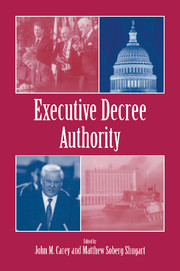Book contents
- Frontmatter
- Contents
- List of Contributors
- Preface
- 1 Calling Out the Tanks or Filling Out the Forms?
- Part I From Delegated to Constitutional Decree Authority
- Part II Constitutional Decree Authority and Conflict Between the Branches
- 6 Dancing Without a Lead: Legislative Decrees in Italy
- 7 The Pen Is Mightier than the Congress: Presidential Decree Power in Brazil
- Part III Absence of Conflict Over Decree
- Appendix of Constitutional Provisions Regarding Decree
- References
- Index
6 - Dancing Without a Lead: Legislative Decrees in Italy
Published online by Cambridge University Press: 18 December 2009
- Frontmatter
- Contents
- List of Contributors
- Preface
- 1 Calling Out the Tanks or Filling Out the Forms?
- Part I From Delegated to Constitutional Decree Authority
- Part II Constitutional Decree Authority and Conflict Between the Branches
- 6 Dancing Without a Lead: Legislative Decrees in Italy
- 7 The Pen Is Mightier than the Congress: Presidential Decree Power in Brazil
- Part III Absence of Conflict Over Decree
- Appendix of Constitutional Provisions Regarding Decree
- References
- Index
Summary
Perhaps in no other advanced industrialized democracy has government use of decree legislation become so common in the legislative process as it has in Italy since the mid-1970s. There is a certain paradox in this development, because decrees often are seen as the expropriation of the legislature's decision-making powers by an executive intent on providing leadership and direction. Yet Italian governments, which have been so generous in their use of decrees, have been described as anything but strong and decisive; nor have they been able to provide policy and political leadership (Cassese 1980). This brings us to one of the questions raised by Carey and Shugart in the first chapter of this book – namely, do decrees necessarily imply the displacement of law-making and political powers from the legislature to the executive? If not, what factors may account for the use of decrees and what does this tell us not only about the legislative process, but of the balance of power between institutions and between political forces?
The Italian case suggests that some significant revisions in the conventional understanding of decree legislation may be in order. First, Italy has a parliamentary and not a presidential system of government. As other chapters in this volume indicate, attempts by presidents to usurp law-making powers of legislatures are not uncommon in many presidential systems. However, the conventional view of parliamentary systems assumes that the legislature's ability to discipline the executive discourages the use of nondelegated decree authority in law making.
- Type
- Chapter
- Information
- Executive Decree Authority , pp. 175 - 196Publisher: Cambridge University PressPrint publication year: 1998
- 6
- Cited by

